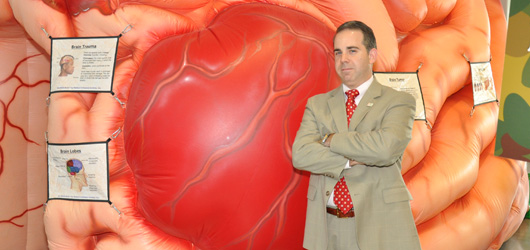
Christopher McPherson, MD, a neurosurgeon with the Mayfield Clinic and UC Brain Tumor Center, had encouraging words for those affected by brain tumors Saturday at the Cincinnati Combats Cancer event at the Cintas Center. During his lecture he described an array of treatments that are evolving rapidly for the benefit of patients. Brain tumor care has come a vast way since Dr. Harvey Cushing removed the first brain tumor in 1894, a light fastened to his forehead and only his hands for tools.“Sometimes people feel that, oh, a brain tumor, there’s no hope,” Dr. McPherson said. “But we have a growing number of tools in our arsenal, and we are excited not only about what we have but also about what is on the way, from surgery, to radiation therapy, to chemotherapy.”
Getting there is half the battle, and enormous advances have occurred in doctors’ ability to locate a tumor and navigate safely toward it through the labyrinth of arteries, veins, nerves and “roadway tracts” that enable the brain to thrive, process, react and communicate. Image-guided surgery – GPS for the brain – and multiple types of brain scans enable doctors to view everything from the chemical makeup and energy of a tumor to the brain’s language and movement centers. The difference between yesterday’s imaging and today’s, Dr. McPherson says, is “like your 19-inch black and white TV 30 years ago and your large, full-color, flat-screen TV.”
Meanwhile, exciting diagnostic advances are the horizon:
- nano-particle imaging, a process in which microscopic particles are first absorbed by the tumor, will enhance visibility by illuminating the tumor in color;
- molecular imaging, which is being used in Europe and will soon come to the United States, will enable physicians to ensure that every last spot of cancer has been removed;
- molecular profiling of brain tumors, which is nearing reality, will enable physicians to match a chemotherapy treatment to an individual’s specific type of tumor.
Surgical advances in use today include techniques and sophisticated tools that enable doctors to reach brain tumors through tiny pathways that begin in the nose or above the eyelid. Chemotherapy advances enable patients who are prescribed temozolomide to take a pill rather than sit in a chair with an IV drip attached to their arm.
In the realm of radiation, proton beam therapy enables radiation oncologists to target a tumor with a shaped beam that stops at the tumor’s base, rather than passing through into healthy tissue. Proton beam therapy systems, which cost in the tens of millions, are not widely available in the United States, and Dr. McPherson said Cincinnati is hoping to acquire the technology in the not-too-distant future.
Perhaps most futuristic of all are the brain tumor vaccines, which are now being studied in national, multi-site clinical trials that include the UC Brain Tumor Center.
— Cindy Starr